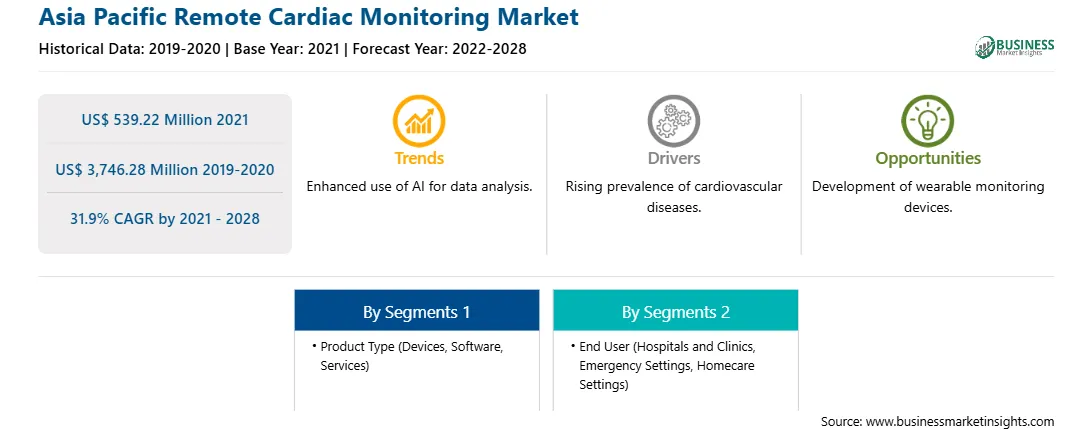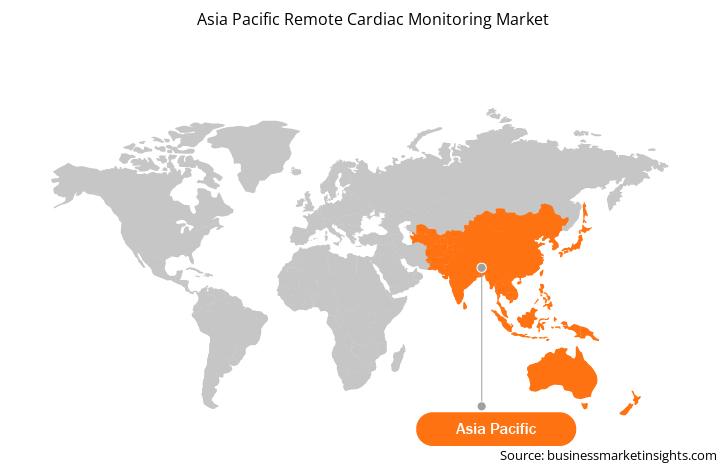Asia Pacific consists of five major countries namely China, Japan, India, Australia, and South Korea. The market is also evaluated for the rest of countries in Asia Pacific. The market is driven by the factors such as by growing emphasis on cost optimization, focus on streamlining of clinical processes, and increasing number of clinical trials. In most of the cardiac disorders, continuous cardiac monitoring is required. A rise in the government initiatives, growing number of research and development activities, and rising number of product launches and approvals in the region are also some of the reasons towards the growth of the market. Due to the rapid socio-economic development, environmental problems, lifestyle changes, and urbanization, China faces several obstacles in maintaining and improving people's health. The Chinese government announced the Healthy China 2030 Plan, emphasizing the strategic importance of health for China's growth. In 2018 there were almost 506,003 public primary care facilities and around 437,636 private village clinics. In 2018 there were about 12,000 public hospitals and 21,000 private hospitals (excluding city and community hospitals), of which about 20,500 were non-profit, and 12,600 were for-profit. With investment in the healthcare sector increasing and the rate of heart disease rising, China is deriving the demand for the remote heart monitoring market. The Chinese government is urging hospitals to start using the internet in their doctor's offices. The aim is to promote telemedicine technologies that would enable patients and clinicians in impoverished areas to consult the best doctors in the country, usually based in larger cities such as Beijing and Shanghai. Remote health diagnosis and monitoring related to people outside the classic hospital setting, typically at home and through mobile clinics. Medical expenses are becoming financial distress for families, and high-quality medical resources cannot meet public demand. China, the first country to emerge with the disease, was also the first to develop innovative remote heart monitoring methods to assist clinical staff and public health professionals. Perhaps the most obvious remote heart monitoring technology most citizens own is the smartphone, which offers everything from telemedical advice and symptom testing to apps and websites to approximate heart rate monitoring by the camera and location tracking to identify disease hotspots or contact tracing enables. Experts agree that the global health burden from cardiovascular disease (CVD) increases and affects rural residents disproportionately.
The COVID-19 pandemic has critically influenced the region and has also allowed stakeholders to realign their future path based on strategic intent and focus. Moreover, various companies have been manufacturing patient monitoring devices with biosensors for easy and quick results. Reports have indicated that the usage of pulse oximeters in hospitals and at home has increased substantially amid this pandemic. The governments in a few countries are providing reimbursement for pulse oximeter purchases. For instance, in June 2020, the Union Health Ministry of India has decided to reimburse the cost of pulse oximeter purchased by beneficiaries Central Government Health Scheme (CGHS). They are tested positive as a supportive measure for COVID-19 patients monitoring at-home care during the pandemic.

Strategic insights for the Asia Pacific Remote Cardiac Monitoring provides data-driven analysis of the industry landscape, including current trends, key players, and regional nuances. These insights offer actionable recommendations, enabling readers to differentiate themselves from competitors by identifying untapped segments or developing unique value propositions. Leveraging data analytics, these insights help industry players anticipate the market shifts, whether investors, manufacturers, or other stakeholders. A future-oriented perspective is essential, helping stakeholders anticipate market shifts and position themselves for long-term success in this dynamic region. Ultimately, effective strategic insights empower readers to make informed decisions that drive profitability and achieve their business objectives within the market.

| Report Attribute | Details |
|---|---|
| Market size in 2021 | US$ 539.22 Million |
| Market Size by 2028 | US$ 3,746.28 Million |
| Global CAGR (2021 - 2028) | 31.9% |
| Historical Data | 2019-2020 |
| Forecast period | 2022-2028 |
| Segments Covered |
By Product Type
|
| Regions and Countries Covered | Asia-Pacific
|
| Market leaders and key company profiles |
The geographic scope of the Asia Pacific Remote Cardiac Monitoring refers to the specific areas in which a business operates and competes. Understanding local distinctions, such as diverse consumer preferences (e.g., demand for specific plug types or battery backup durations), varying economic conditions, and regulatory environments, is crucial for tailoring strategies to specific markets. Businesses can expand their reach by identifying underserved areas or adapting their offerings to meet local demands. A clear market focus allows for more effective resource allocation, targeted marketing campaigns, and better positioning against local competitors, ultimately driving growth in those targeted areas.

The remote cardiac monitoring market in APAC is expected to grow from US$ 539.22 million in 2021 to US$ 3,746.28 million by 2028; it is estimated to grow at a CAGR of 31.9% from 2021 to 2028. Continuous evolution in telemedicine approach; as defined by Office for the Advancement of Telehealth, telehealth comprises the use of telecommunications and information technologies to share information as well as to remotely provide clinical care, health education, public health, and administrative services. It has the potential to help transform healthcare systems, simultaneously reducing costs as well as boosting quality, patient-centeredness, and patient satisfaction. To successfully treat heart-related diseases, including CVDs, health professionals encourage patients to make lifestyle changes, continue a regular course of medication, and rigorously follow the follow-up schedule. However, despite the potential health benefits of regular doctor appointments and tests, clinic visits may act as an imposition on patients’ daily lives. As a result, disruptions in follow-up have become a common issue. Further, this situation has worsened with the pandemic. Clinic visits and elective procedures were suspended, and patients avoided visiting clinics due to the fear of SARS-CoV-2 infection. Telehealth helps health systems in overcoming a few of the systemic barriers in monitoring heart diseases and CVDs. Technological solutions address the challenges posed by physical distance and facilitate personal interactions between doctors and patients. The doctors can remotely monitor conditions that contribute to heart attack and stroke, providing an opportunity to implement primary and secondary cardiovascular prevention without asking patients to visit the clinics. Patients can get any tests done before the appointment at a lab close to their home; they can also measure their blood pressure with an automatic blood pressure cuff at home, local pharmacies, or senior centers. Telehealth appointments are more convenient than in-person clinic visits for both doctors and patients. The introduction of remote monitoring of health data using wireless devices that measure weight, blood pressure, blood sugar, pulse, and heart rhythm could further advance telehealth services. Moreover, the telemedicine approach uses remote patient monitoring systems or devices to keep a check on the health status of patients. Along with cardiac monitors, companies are also working on developing monitoring devices for hematology, including blood glucose monitors, and for respiratory diseases, including sleep apnea and respiratory rate monitors. This is bolstering the growth of the remote cardiac monitoring market.
Based on product type, the market is segmented into devices, software, and services. In 2021, the devices segment held the largest share APAC remote cardiac monitoring market. Based on devices the market is divided into vital signs monitors, heart rate monitors, blood pressure monitors, breath monitors, holter monitors, and others. Vital signs monitors is expected to the fastest growing segment over the forecast period. Based on software the market is divided into cloud based software and on-premise software. The cloud based software segment accounts for largest market share in the 2021. Similarly, based on end user, the market is segmented into hospitals and clinics, emergency settings, homecare settings and others. In 2021, the hospitals and clinics segment held the largest share of the market.
A few major primary and secondary sources referred to for preparing this report on the remote cardiac monitoring market in APAC are company websites, annual reports, financial reports, national government documents, and statistical database, among others. Major companies listed in the report are Abbott; Biotronik, Inc.; Boston Scientific Corporation; GE Healthcare; Honeywell International Inc.; Koninklijke Philips N.V.; Medtronic; Nihon Kohden Corporation; and OSI Systems, Inc. among others.
The Asia Pacific Remote Cardiac Monitoring Market is valued at US$ 539.22 Million in 2021, it is projected to reach US$ 3,746.28 Million by 2028.
As per our report Asia Pacific Remote Cardiac Monitoring Market, the market size is valued at US$ 539.22 Million in 2021, projecting it to reach US$ 3,746.28 Million by 2028. This translates to a CAGR of approximately 31.9% during the forecast period.
The Asia Pacific Remote Cardiac Monitoring Market report typically cover these key segments-
The historic period, base year, and forecast period can vary slightly depending on the specific market research report. However, for the Asia Pacific Remote Cardiac Monitoring Market report:
The Asia Pacific Remote Cardiac Monitoring Market is populated by several key players, each contributing to its growth and innovation. Some of the major players include:
The Asia Pacific Remote Cardiac Monitoring Market report is valuable for diverse stakeholders, including:
Essentially, anyone involved in or considering involvement in the Asia Pacific Remote Cardiac Monitoring Market value chain can benefit from the information contained in a comprehensive market report.